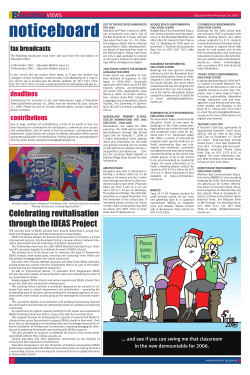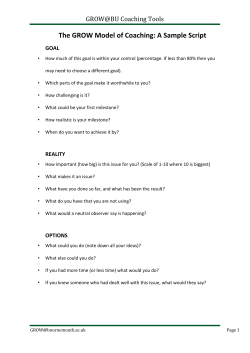
Developing Performance Framework Information session for public servants
Developing Performance Framework Information session for public servants Strategic Alignment Independent Commission of Audit Final Report April 2013 Code of Conduct for the QPS A Plan – Better Services for Queenslanders Valuing Performance Policy Statement Developing Performance Framework Developing Performance process Developing Performance across DETE for every employee group across every phase of their career Education Queensland Capability and Standards Framework through shared responsibility, Developing Performance Framework professional relationships and targeted capability development 3 Senior Executive QPS Capability Service Performance & Leadership and Development Framework Framework Session overview Purpose of the Developing Performance Framework? Links to capability framework documents Continual improvement and change Team structures in a Developing Performance culture Developing Performance conversations and planning 4 Discussion What has been your experience of performance development processes? What do you believe is your greatest strength in your current work role? What was the best professional development you have experienced and how did it support your development? What makes you feel valued in your workplace? 5 Purpose of the framework The intent of the Developing Performance Framework is to promote and maintain a culture in which all employees engage in conversations about performance and its development. 6 Strategic alignment E Cascading nature of planning: • Government initiatives • DETE Strategic Plan • Regional/branch operational planning • Implementation of business/school/unit plans • Individual Developing Performance plans Alignment at all levels ensures a clear line of sight between work and strategic priorities. 7 Developing Performance Key resources = + Process + Web resources Capability and standards frameworks Capability Frameworks: http://education.qld.gov.au/staff/development/performance/toolkit/capability-frameworks.html Developing Performance Framework http://education.qld.gov.au/staff/development/performance/ 8 Capability Frameworks Education Queensland Principals’ Capability and Leadership Framework Australian Professional Standards for Teachers (from 2014) http://www.teacherstandards.aitsl.edu.au/ Queensland Public Service Capability and Leadership Framework http://www.psc.qld.gov.au/foremployees/performance-anddevelopment/capability-frameworks.aspx https://learningplace.eq.edu.au/cx/re sources/items/ae65cf7e-6489-a57843f34e77f234dc94/1/index.html?.hb=true Deputy Principals' and Head of Programs' Capability and Leadership Framework https://learningplace.eq.edu.au/cx/res ources/file/dcead650-922a-47a894d8-7400a8bfdd77/1/index.html Senior Executive Service Performance and Development Framework http://education.qld.gov.au/staff/develo pment/performance/toolkit/capabilityframeworks.html 9 DP implementation guide Key resource Used effectively, this guide provides: • Useful information for implementing the four phases of the Developing Performance Framework • Hints and tips as you work through the process • Ideas and resources to help both team leaders and team members along the way DP conversation & plan template Key resource Phase 1: Clarifying expectations and work focus DP conversation & plan template Phase 2: Reaching an agreement Phase 3: Performing and ongoing support, including coaching and feedback Phase 4: Reviewing progress and recognising achievement Queensland Public Service Capability and Leadership Framework A detailed PowerPoint introduction to the CLF can be located at http://education.qld.gov.au/st aff/development/performance /toolkit/presentations.html http://www.psc.qld.gov.au/publications/subject-specific13 publications/capability-leadership-framework.aspx Queensland Public Service Capability and Leadership Framework The CLF is built on five core capabilities: 1. Supports/shapes strategic direction/thinking 2. Achieves results 3. Supports/cultivates productive working relationships 4. Displays/exemplifies personal drive and integrity 5. Communicates with influence 14 Queensland Public Service Capability and Leadership Framework Capability Components Descriptions Behavioural indicators 15 Alignment of CLF levels with classifications AO CLF 1 1 CLF 2 2 CLF 3 3 CLF 4 4 CLF 5 PO TO OO AO Administration Officer PO Professional Officer TO Technical Officer OO Operational Officer 1 1 1 2,3 2 4,5 2 3 6 5 3 4 7 CLF 6 6 4 5 CLF 7 7 5 6 CLF 8 8 6 CLF 9 SO1, SO2 16 Building a Performance Development culture includes … • a leadership focus • coaching for performance • professional development continuous and constructive feedback • recognising achievement • supporting the development of individual employees • employees having ownership over their own development. 17 Continual improvement requires change • Implementation of the Developing Performance Framework aims to improve the capability and performance of all staff • This often means that we need to change the way we work in some way/s. 18 Change is part of our lives – suggest ditch this slide With any change Emotions ENDING BEGINNING Physical 1. YES! 5. Inappropriate displays of emotion (e.g. oppositional, cynical) 2. Exaggerating the change (e.g. turning it into a catastrophe) 3. Focusing on irrelevant detail 6. Shutdown and avoidance (go to a happy place) 4. Busy doing the unimportant 7. Sabotage These are all normal … for a while! Adapted from the work of Bruce Sullivan http://www.brucesullivan.com.au/ 19 Team leader/member • Team leader refers to those leading or coaching a developing performance conversation • Team member refers to everyone participating in a developing performance conversation with their team leader. Team Leader Role As a team leader, your role is to: • assist your team members to identify key work tasks • support your team members as they undertake their work tasks • have open discussions about professional practice and career aspirations with your team members • identify and make the best use of support and professional development options available. 21 Team Member Role As a team member, your role is to work with your team leader to: • identify your key work tasks • gain support to undertake key work tasks • have open discussions about professional practice and career aspirations • identify and make the best use of support and professional development options. . 22 Team structures Supervisory approach Collegial approach Traditionally, teams are organised based on classification and position. Teams are structured outside of the supervisory approach. Leadership is distributed among team members. Often there is a pre-existing structure of teams. Collaborative thought is given to the way teams are structured. 23 Team structure example Collegial team structure in a work unit Team Team leader 2 x Managers Director 3 x A07 staff members Manager 1 x A06, 2 x A05 staff members A07 2 x A06, 1 x A05 staff members A07 2 x A04, 1 x A03 staff members A06 1 x A03, 3 x A02 staff members A06 24 The DP process Phase 1 – Clarifying expectations and work focus Phase 2 – Reaching an agreement Phase 3 – Performing and ongoing support, including coaching and feedback Phase 4 – Reviewing progress and recognising achievement Key resource 25 The process Phase 1: Clarifying expectations and work focus Discussions to reach a shared understanding of: • expectations • day-to-day work tasks that will be a focus for development • support and professional development options to enable you to carry out these tasks • career aspirations 26 The process Phase 2: Reaching an agreement Discussions to decide and agree on: • development areas within key work tasks • support and professional development to build capabilities in these areas • career goal/s 27 Effective professional development Research suggests that: • 10% of learning is from formal training events alone • 20% of learning is affected through working with a coach, mentor or more experienced colleagues • 70% of learning happens informally through on-the-job and off-the-job interactions. (Lombardo and Eichinger 2003, The Leadership Machine) 28 Goal setting Page 19 Implementation Guide 29 Goal stem (date) By ______ I will (what you wish to achieve) _______________ so that _________ (benefit to self/organisation) ______________. Growth Coaching International Page 19 Implementation Guide Goal examples • By the end of April I will communicate with influence to various audiences so that key project information is communicated clearly, accurately and tailored to the needs of the audience. • By the end of April I will develop active listening and share information with my colleagues, so that I operate as an effective team member to achieve the best outcomes for the workplace/organisation. The process Phase 3: Performing and ongoing support, including coaching and feedback Regular conversations to: • update each other on progress • give and receive feedback • talk about things that have been working and things that have not • discuss new issues or priorities 32 Structuring feedback - STAR Situation … the context at the time Feedback - STAR ‘‘When I had to rush to the meeting this morning… ‘ Task … what they were doing ‘ ... and you offered to help me with the report… ’ Action … specifically what you want to acknowledge in their behaviour or action ‘ … the way you were able to deliver the report to Sue and spend time answering her questions…’ Results … consequences/effects of this behaviour or action ‘… resulted in Sue’s area being really impressed with our responsiveness and your knowledge of the project. It looks like she is going to support our application!’ 33 The process Phase 4: Reviewing progress and recognising achievement Reflecting on: • successes and how your capabilities have developed • agreed actions that worked and did not work • areas for further development (during the next work period) 34 Developing Performance – Key Resources • Developing Performance implementation guide for schools This resource contains information to support employees in understanding and implementing the Developing Performance process. • Developing Performance – conversation and plan template The template supports team leaders and team members in preparing for, participating in, and facilitating Developing Performance conversations. • Developing Performance – a step-by-step guide to the Developing Performance conversation and plan template for school staff This guide clarifies each step in the template and the corresponding process that occurs between team leaders and team members. • Developing Performance website http://education.qld.gov.au/staff/development/performance/index.html • Mentoring Handbook This handbook provides an overview of mentoring, provides guidance on how to establish a formal mentoring program and how to work with a partner in a mentoring relationship. 35 What’s in it for me? ‘ ... it is about job satisfaction, spending your days in a place where you feel valued and supported when carrying out your day-to-day tasks as well as when facing new challenges, where you can discuss your learning and that of others, where improvement is planned for and does not just happen randomly and by chance … ’ (Pilot participant, 2008) 36
© Copyright 2025











